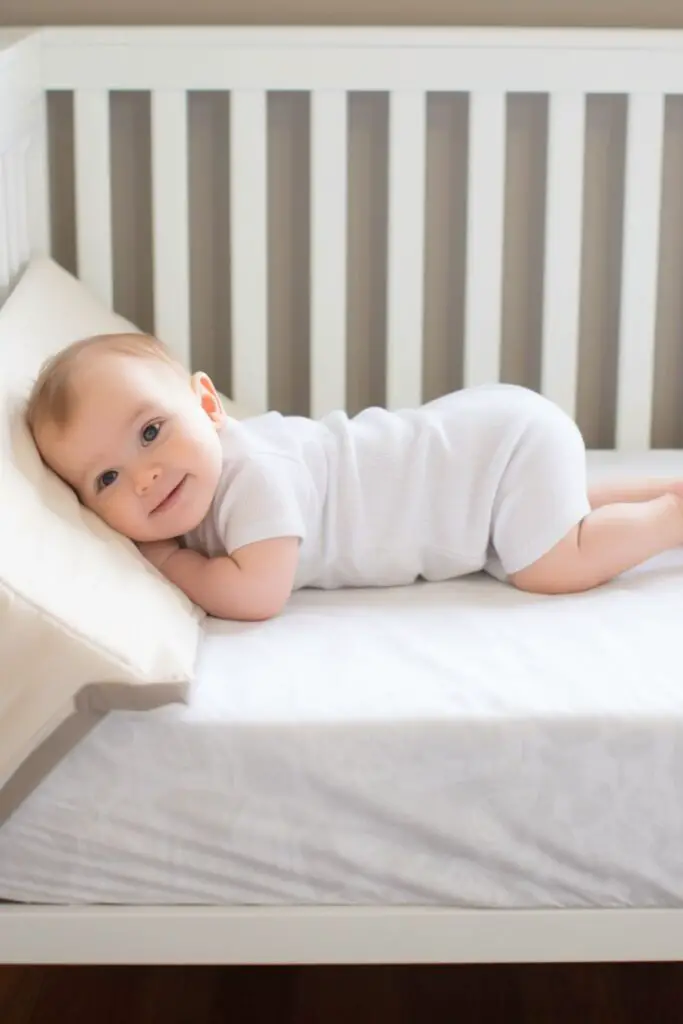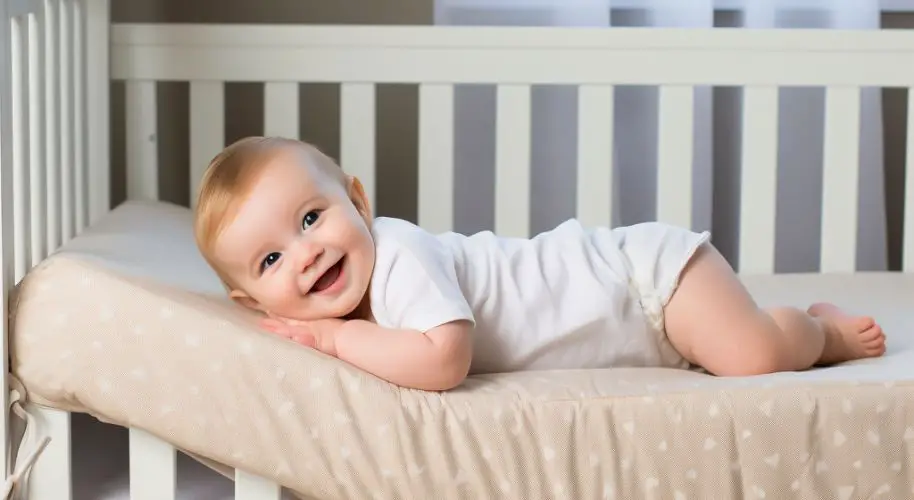Last Updated on June 5, 2025
Raising a little one is a journey filled with countless questions and decisions. One such decision that often gets overlooked, but is crucial to your baby’s comfort and safety, is the proper adjustment of their crib mattress.
In this blog post, we’re going to shed some light on the subject of “How To Raise A Crib Mattress”. We’ll walk you through the reasons why adjusting your crib mattress height is important, when it’s time to make the change, and how you can do it safely and effectively.
So whether you’re a new parent, or simply someone looking to ensure the best for the tiny tot in your life, read on and let us guide you through this seemingly small, but significantly important aspect of parenthood.

Step-By-Step Guide On How To Raise Crib Mattress
Raising a crib mattress involves a few simple steps that I’ve gathered from various sources. Here’s a general step-by-step guide:
- Gather Your Tools and Materials: You’ll likely need a screwdriver or Allen key, depending on the design of your crib.
- Measure the Crib Mattress: This step is important to ensure that the adjustments you make are suitable for the size of the mattress.
- Adjust the Mattress Support Hangers: The hangers are usually found on the sides of the crib. They rest on the support hooks installed on the crib’s footboard. You’ll need to repeat this step for both the right and left mattress support hangers.
- Unscrew the Foundation: If needed, you can unscrew the whole foundation to lower it. However, if you’re raising the crib mattress, you may need to move the foundation up.
- Reattach the Foundation at the Desired Level: Once you’ve adjusted the foundation to the desired level, re-screw it tightly.
- Check the Mattress Height: After making adjustments, ensure that the mattress height is safe and comfortable for your child.
The exact process can vary depending on the specific model of your crib. Always refer to your crib’s instruction manual for precise guidance.
The recommended crib mattress height can vary based on the age and mobility of your baby. Generally, the highest setting is recommended for babies under 5 months who are immobile. When your baby starts to become mobile (around 6-8 months), the mattress should be lowered.
And remember, safety is paramount when adjusting a crib mattress. Never create a makeshift solution that could compromise the structural integrity of the crib or pose a safety risk to your child.
What Are The Benefits Of Raising Crib Mattresses?
Raising a crib mattress comes with several benefits, primarily centered around safety and comfort for both the baby and parents. Here are some key benefits:
Ensures Safety:
The primary purpose of raising or lowering a crib mattress is to ensure the baby’s safety. When babies are young and immobile, a higher mattress allows parents to easily lift them out of the crib. As babies grow and learn to sit, stand, and eventually climb, lowering the mattress prevents them from climbing or falling out of the crib.
Promotes Comfort:
Adjusting the crib mattress to the appropriate height can make it more comfortable for the baby. For newborns, a higher mattress position means they are closer to their parents, which can provide a sense of security.
Eases Physical Strain for Parents:
A higher mattress level can lessen the physical strain on parents, particularly right after childbirth when bending over may be difficult. It makes lifting the baby in and out of the crib easier.
Flexibility and Longevity:
Adjustable crib mattresses offer the flexibility to adapt to your child’s growth and development stages. This means you won’t need to buy a new crib as your child grows, offering potential cost savings.
Remember, while adjusting a crib mattress has its benefits, it should always be done safely, following the manufacturer’s instructions and guidelines.
You Might also Like These Resources!
- When Your Baby Has Outgrown the Bassinet but Isn’t Ready for a Crib
- Neatly Folding Crib Sheets: A How-To Guide
What Is The Recommended Starting Crib Mattress Height For A Baby?

The recommended starting crib mattress height for a newborn baby is typically the highest setting. This is because newborns are immobile and cannot sit up or roll over. The higher mattress height makes it easier for parents to reach in and pick up the baby, reducing strain on the parent’s back.
However, as soon as the baby begins to push up on their hands and knees or pull up to a standing position (usually around 5-6 months), the mattress should be lowered to prevent the baby from climbing or falling out of the crib.
It’s important to note that these are general guidelines and can vary depending on the specific design of the crib and the individual baby’s development. Always refer to your crib’s instruction manual and consult with your pediatrician if you have any concerns.
How Safe is Crib Mattress Height?
The safety of crib mattress height is largely dependent on the baby’s age and mobility. Here are some key points from various sources:
Highest Position: For newborns who can’t sit up and are under 5 months old, the highest mattress position is generally considered safe. This setting facilitates easy lifting of the baby by parents and reduces the risk of the baby rolling over or falling out.
Lower Positions: Once a baby starts to sit up unassisted, which typically happens between 5 and 8 months old, the crib mattress should be lowered. This adjustment prevents the baby from climbing or falling out of the crib as they become more mobile.
Safety Standards: According to the American Academy of Pediatrics (AAP), at its tallest setting, the crib mattress should be no less than 26 inches below the side rail. Furthermore, there should be at least 26 inches between the bottom of the baby’s crib mattress and the top of the crib rail.
Crib Regulations: The US federal crib regulations require parents and caregivers to stop using the crib once the baby reaches the height of 35 inches.
These guidelines aim to prevent accidents like falls and entrapment. However, it’s crucial to monitor your child’s development and adjust the mattress height accordingly, even if they haven’t reached the typical age range. Always refer to the instruction manual of your specific crib model for accurate information.
When Should I Change the Mattress Height?
The timing for changing the mattress height in your baby’s crib is typically associated with their developmental milestones, rather than their age. Here are some indicators that it might be time to adjust the crib mattress:
When Your Baby Starts Rolling Over
Once your baby starts to roll over, usually around 3-6 months, you should consider lowering the mattress to prevent them from accidentally rolling out of the crib.
When Your Baby Can Sit Up
As soon as your baby can sit up on their own, which typically happens between 5 and 8 months, the crib mattress should be lowered further to ensure they can’t topple out.
When Your Baby Pulls Up to Stand
When your baby begins to pull themselves up to a standing position, usually around 9 months, the crib mattress should be adjusted to its lowest setting. This prevents the baby from climbing or falling out of the crib.
When Your Baby Starts Climbing
If your baby shows signs of trying to climb out of the crib, lower the mattress to its lowest setting if you haven’t already. If your child can climb out even at the lowest setting, it’s time to transition them to a toddler bed or a mattress on the floor.
Always monitor your baby’s development and adjust the crib mattress height accordingly.
When Using A Notched Mattress, Is It Safe To Bend The Floor?
A notched mattress is designed to fit securely in a crib or bed frame with a specific shape or design. When it comes to bending the floor of the crib or bed to accommodate the notched mattress, it’s important to consider safety first.
Generally, bending or modifying the original structure of a crib or bed is not recommended. It could compromise the stability and safety of the furniture, potentially putting your baby at risk. This could lead to hazardous situations such as the mattress not fitting properly, creating gaps where a baby could become trapped, or the crib collapsing due to structural instability.
If you have a notched mattress that doesn’t fit correctly into your crib or bed, it’s advisable to consult with the manufacturer or a professional before making any adjustments. They can provide guidance based on the specific design of the furniture and mattress.
However, the safest option would be to use a mattress that fits perfectly in the crib or bed without any need for modification. The U.S. Consumer Product Safety Commission (CPSC) recommends that cribs should have a firm, tight-fitting mattress so a baby cannot get trapped between the mattress and the crib.
FAQs
Can all cribs have their mattresses raised?
Most modern cribs come with adjustable mattress heights, but always check the specific features of your crib model.
Can raising the crib mattress help my baby sleep better?
There’s no definitive evidence that raising the crib mattress improves sleep, and safety should always be the priority.
Can I use pillows or blankets to raise the crib mattress?
No, using pillows or blankets is not safe as they can pose a suffocation risk to your baby.
Finally,
The height of a crib mattress plays a crucial role in your baby’s safety and comfort. Starting at the highest level for newborns, it should be lowered incrementally as your baby grows and reaches new developmental milestones.
Always refer to the manufacturer’s instructions when adjusting the mattress height and consult with healthcare professionals if you’re considering elevating the mattress for medical reasons.
Remember, every child develops at their own pace, so it’s essential to monitor their progress and adjust the crib settings accordingly.
You Might Also Like These Latest Content!
- Storing Your Baby Bathtub: Practical Tips
- Adjusting the Temperature Settings on an Infant Optics Monitor
- Putting On the Owlet Sock: Step-By-Step Guide

Amy A. Vincent is a Certified Pediatric Sleep Consultant and a mother of three beautiful children. She helps parents transition their babies from swing sleep to safe, independent sleep. She is passionate about helping parents teach their children the skills needed to become good sleepers and aims to make the process as easy and stress-free as possible. Read more
